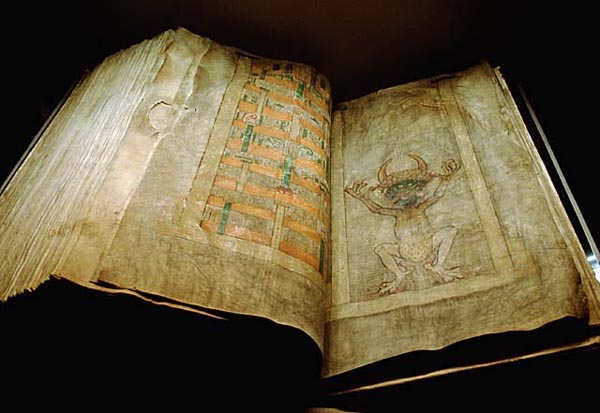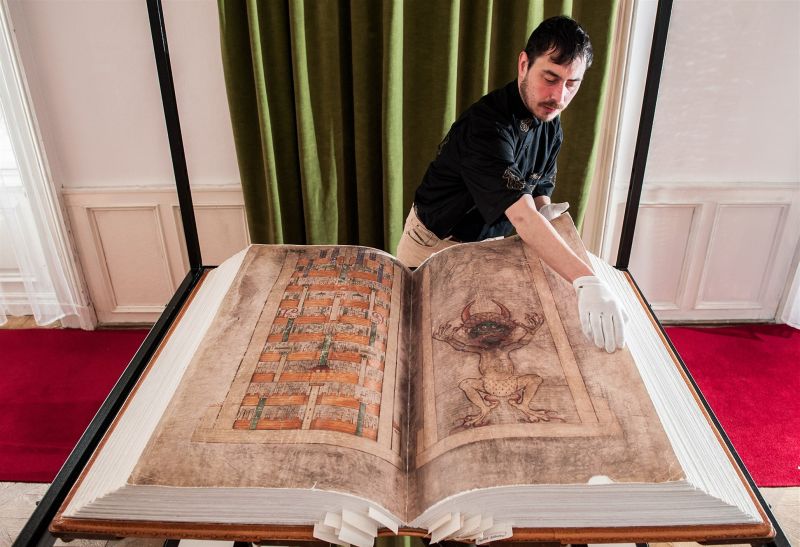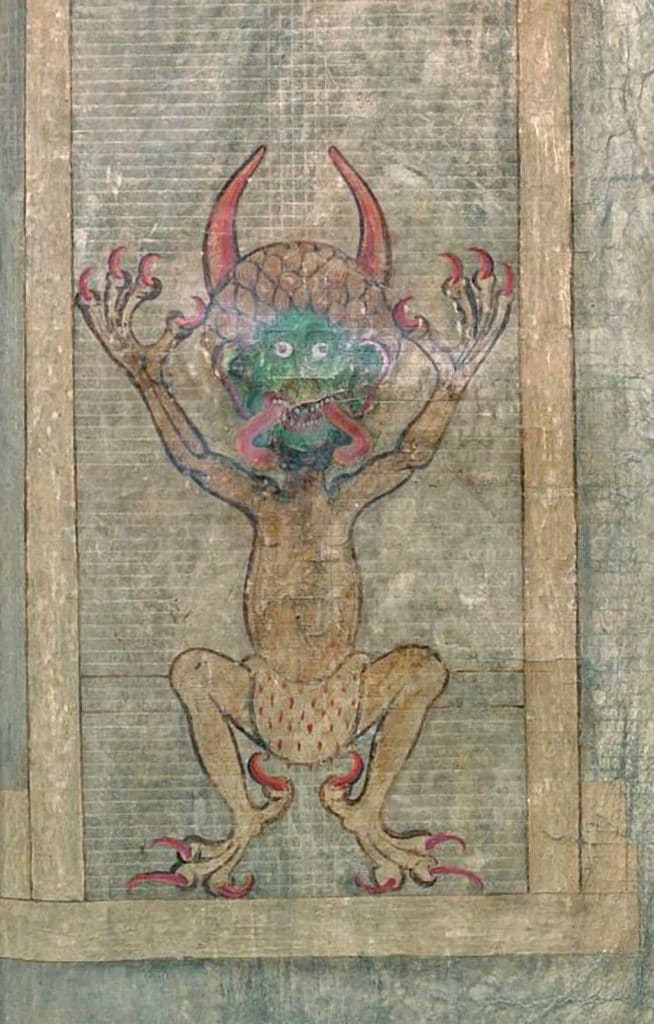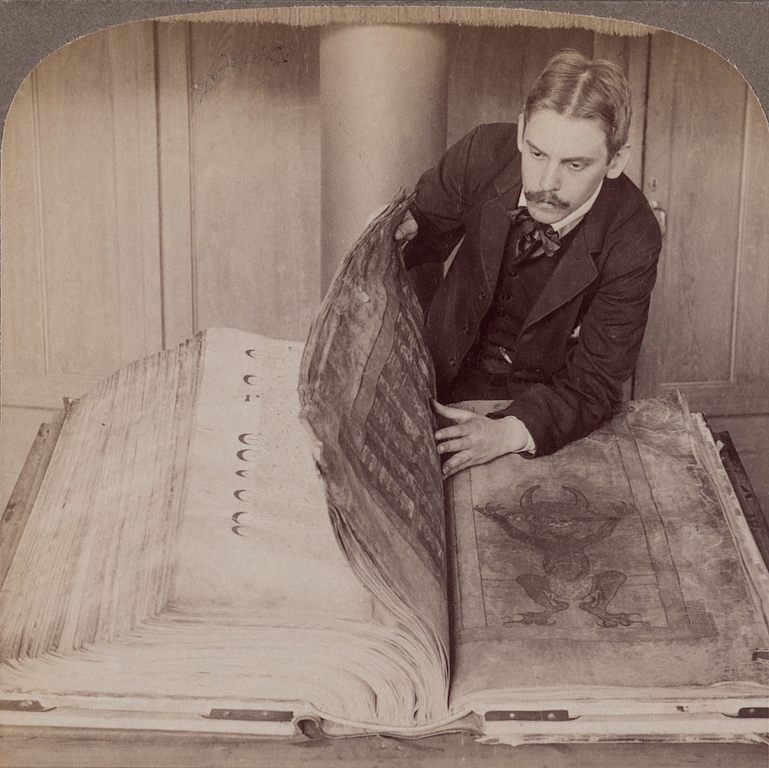Last updated on January 29th, 2023 at 08:09 pm
The Codex Gigas, also known as the Devil’s Bible, is a medieval manuscript infamous for its large size and inclusion of a full-page illustration of the devil. But what is this document, and what is its history? And why has it been called the Devil’s Bible? Keep reading as we unravel the mystery of this ancient text.

The Codex Gigas
The Codex Gigas is a medieval manuscript that dates back to the 13th century. It is believed to have been created in Bohemia at the Podlazice monastery, now part of the Czech Republic. The text of the Codex Gigas consists of a Latin translation of the Bible and other religious texts.
This mysterious, leatherbound book is at least 800 years old and is full of religious, historical, medical, and magic-related texts. The manuscript is currently on display in Stockholm’s National Library of Sweden.
One of the characteristics that make the Codex Gigas unique is its size. The manuscript is approximately 36 inches tall, 20 inches wide, and close to 9 inches thick.
It weighs 165 pounds, making it the most extensively known medieval manuscript globally. Experts believe that one person wrote the Codex Gigas due to the uniform nature of the handwriting and illustrations throughout the text.
Due to the nature of the manuscript’s design, it’s believed that it took the scribe 30 years to complete the manuscript, meaning that this person spent most of their life working on it

Many experts have examined the codex throughout the years and determined that it contains quite a bit of painstakingly crafted and designed knowledge. It was a labor of love and required extreme mental and physical discipline.
In terms of information, the manuscript contains the complete versions of the Old and New Testament, The Antiquities and The Jewish War by Flavius Josephus, some medical texts, some shorter works, the Chronicle of Bohemia, and the Encyclopedia. Some even say that the book possessed the Rule of St. Benedict, but history eventually lost it.
However, although its mere existence is a testament to the skill of its creators, the Codex Gigas is not just a large book.
The Devil’s Bible
The Codex Gigas gets its nickname, “The Devil’s Bible,” from a full-page illustration of the devil that can be found within its pages. The image shows the devil seated on a throne with outstretched arms and legs.
Flames and devils surround him, and his eyes seem to follow the reader as they flip through the pages of the Codex Gigas. The devil sits opposite the Kingdom of Heaven, illustrated on the facing page.

While the devil’s image is striking, the Codex Gigas has a unique and dark history that has earned its nickname. Instead, this ancient text’s history and mystery have earned it the nickname “The Devil’s Bible.”
The Legend of the Codex Gigas
The history of the Codex Gigas is shrouded in mystery. The only thing known is that a single person created the manuscript sometime in the 13th century. Beyond that, little is known about its creation or early history.
One of the most popular theories surrounding the Codex Gigas is that it was created by a monk who was to be executed. According to legend, a monk named Herman the Recluse made the manuscript.
Historical sources mention that he broke his monastic vows and was sentenced to execution by being walled up.
In desperation, he forged a deal where he would write a book containing all the world’s human knowledge and complete it one day. The monk knew that what he had promised would be impossible to deliver and that he was doomed unless he found a solution quickly.
So, instead of enlisting help from someone at the monastery, he invoked the devil to help him finish the manuscript so that he could escape his fate.
It is said that the devil agreed to help Herman the Recluse on the condition that he would give him his soul in return. Herman decided to do the deal and completed the Codex Gigas with the devil’s help.
Supposedly, the picture of Satan depicts the moment when he came to collect Herman’s soul. Other rumors say that the devil’s presence in the codex is a tribute to the manuscript’s author.
Where Has The Codex Gigas Been?
The Codex Gigas has had a long and eventful history. It was first mentioned in 1295 in a monastery inventory from Podlazice, Czech Republic. It is believed that the monk created the manuscript in Bohemia, which is now part of the Czech Republic.
In 1594, Swedish troops stole the Codex Gigas from the monastery during the Thirty Years’ War. The Codex Gigas remained in Sweden until it was returned to Prague in 1883 for a brief time.
However, it didn’t stay there long either. It was taken to the National Library of Sweden in Stockholm, Sweden. To this day, it remains there on public display.
Why Is The Codex Gigas So Important?
The Codex Gigas is essential for several reasons. First and foremost, it is the largest surviving medieval manuscript. It is also one of the most beautifully illuminated manuscripts from the Middle Ages. The Codex Gigas contains over 300 illustrations, including the striking image of the devil.
But, perhaps most importantly, the Codex Gigas is a unique window into the medieval world. The manuscript’s text is a compendium of all human knowledge from the 13th century.

It contains many texts that are otherwise lost or have not survived to the present day. This work is a crucial source for our understanding of the medieval world. The Codex Gigas is a genuinely remarkable manuscript. It is a must-see for anyone interested in the history of the Middle Ages.
Strange Story of the Codex Gigas
Whether or not the legend of the Codex Gigas is true, the fact remains that it is a fascinating and mysterious text. So, if you ever have the chance to see it in person, be sure to take a closer look at the devilish illustration – you might get a glimpse into the soul of the man who created it.

